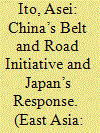|
|
|
Sort Order |
|
|
|
Items / Page
|
|
|
|
|
|
|
| Srl | Item |
| 1 |
ID:
167170


|
|
|
|
|
| Summary/Abstract |
China’s “Belt and Road Initiative (BRI)” has been gaining attention, but the evaluation of the scheme is still unsettled due to its multifaceted nature. This paper examines the basic characteristics of the initiative, disaggregates the initiative into separate dimensions, and traces Japan’s responses toward BRI from 2013 to 2018. From 2013 to 2015, the Japanese government and the Diets committee have discussed the Asian Infrastructure Investment Bank (AIIB) membership issue intensively. Only after 2015, the discussion covered the BRI, wider topics. By looking at responses by the Japanese government, the initial response until 2016 was “non-participation;” however, after 2017, the government has shifted attitude to “conditional engagement” through business cooperation in the third countries especially plus-sum dimension. Such a shift has been backed by a concurrent risk-hedging approach represented by the Indo-Pacific strategy.
|
|
|
|
|
|
|
|
|
|
|
|
|
|
|
|
| 2 |
ID:
167169


|
|
|
|
|
| Summary/Abstract |
The Belt and Road Initiative (BRI), formerly known as One Belt One Road (OBOR), has emerged as one of the top priorities for Chinese President Xi Jinping ever since he unveiled the initiative in 2013. This special issue surveys the reception of BRI in East Asia. As China’s immediate neighborhood, this region will play an important role in determining whether Beijing’s signature project will succeed in the mid- to long term. However, research has thus far mostly focused on BRI’s reception in Central Asia and (Eastern) Europe. In this introduction, we first provide an overview of the literature by identifying three main strands of interpretation on BRI, namely those focusing on geoeconomics, on geopolitics, and on international norms as well as order. Next, we provide a review of the contemporary research on both Southeast Asian and Northeast Asian perceptions of and policy responses to BRI. Finally, we discuss research gaps in the literature and provide an overview of case studies and findings in this special issue. We conclude by identifying recurring themes and characteristics in East Asian responses to BRI.
|
|
|
|
|
|
|
|
|
|
|
|
|
|
|
|
| 3 |
ID:
167171


|
|
|
|
|
| Summary/Abstract |
This article examines South Korea’s response to BRI, focusing on former President Park Geun-hye’s “Eurasia Initiative” as well as current President Moon Jae-In’s “New Southern Policy.” Given Beijing’s preoccupation with political and social stability both domestically as well as in neighboring countries, it argues that there is little doubt that for Beijing economic goals are subordinate components of broader national goals, which in turn formulate the basis for geopolitical calculations. BRI represents an attempt by Beijing’s leadership to shape the rules and norms governing the surrounding regions to better reflect their own preferences. Following Xi Jinping’s launch of BRI, Seoul announced the Eurasia Initiative (EAI) as its own vision for an East-West connection. In calling for a revival of the ancient Silk Road, President Park’s main goal was to foster a flow of economic, political, and social interaction from Europe though the Korean Peninsula. Her policy was driven primarily by political and security motives concerning the division of the Peninsula. Park’s successor, President Moon announced his own foreign policy initiative, the New Southern Policy (NSP), which seeks to strengthen relations with Southeast Asia while continuing to manage relations with Northeast Asia. While NSP at first sight might suggest a new policy direction, the article argues that both EAI and NSP ultimately have sought to change dynamics on the Korean Peninsula and work toward peace with the North. Both policies reflect the Korean fear of vulnerability to great power competition, seeking to foster relations with smaller powers so as to increase Seoul’s foreign policy leverage as a middle power.
|
|
|
|
|
|
|
|
|
|
|
|
|
|
|
|
| 4 |
ID:
167172


|
|
|
|
|
| Summary/Abstract |
East-Asian auteur cinema since 1980s, acclaimed in the global art cinema circuit, has critically examined the idea of the nation-state and cultural identity. In order to put forward the critical discourses of postcoloniality, the East-Asian cinema from the PRC, Taiwan, and South Korea has framed a dialectical relationship between history (of the official version) and memory (of personal experiences). It is interesting to note that the auteur cinema of PRC, Taiwan, and South Korea, which has investigated the relationship between history and memory, often placed the biographical and mythical stories of artists’ lived experiences, which have been marginalized in the official accounts of history, at the center of their narratives. This article aims to discuss how the postcolonial and post-Cold War re-imagination and re-figuration of the national culture in the auteur cinema of the PRC, Taiwan, and South Korea found embodiment in the portrait of artists.
|
|
|
|
|
|
|
|
|
|
|
|
|
|
|
|
| 5 |
ID:
167173


|
|
|
|
|
| Summary/Abstract |
This paper revisits the rise of industrial unionism in Korea in the wake of the 1997 financial crisis at the turn of the twenty-first century. By closely investigating the reorganization of labour unionism in the context of neoliberalization, it challenges the alleged converging impact of neoliberal rhetoric or hegemony on industrial relations. To this end, this paper raises following substantive questions: How far did Korea’s industrial unionism advance under the new economic circumstances and how stable was it? More importantly, what were the fundamental factors behind such re-formation of labour unions? This paper finds that the transformation of labour unions in Korea is a mixture of the rise of industrial unionism and the persistence of enterprise unionism, that is to say a precarious progress of industrial unionism. It argues that behind the unstable development of industrial unionism in Korea were state-fostered legacy of power imbalance within labour in favour of enterprise unions, especially at chaebols, and continuing state intervention in the re-formation of labour unions in the neoliberal era. Finally, it argues that the seemingly sweeping neoliberal rhetoric or hegemony does not override the long-standing political-economic institutions of industrial relations and the leverage of the state, but it is filtered and reified by them.
|
|
|
|
|
|
|
|
|
|
|
|
|
|
|
|
|
|
|
|
|